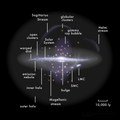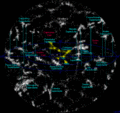Top Qs
Timeline
Chat
Perspective
Location of Earth
Location of Earth in the Universe From Wikipedia, the free encyclopedia
Remove ads
Knowledge of the location of Earth has been shaped by 400 years of telescopic observations, and has expanded radically since the start of the 20th century. Initially, Earth was believed to be the center of the Universe, which consisted only of those planets visible with the naked eye and an outlying sphere of fixed stars.[1] After the acceptance of the heliocentric model in the 17th century, observations by William Herschel and others showed that the Sun lay within a vast, disc-shaped galaxy of stars.[2] By the 20th century, observations of spiral nebulae revealed that the Milky Way galaxy was one of billions in an expanding universe,[3][4] grouped into clusters and superclusters. By the end of the 20th century, the overall structure of the visible universe was becoming clearer, with superclusters forming into a vast web of filaments and voids.[5] Superclusters, filaments and voids are the largest coherent structures in the Universe that we can observe.[6] At still larger scales (over 1000 megaparsecs[a]) the Universe becomes homogeneous, meaning that all its parts have on average the same density, composition and structure.[7]
Since there is believed to be no "center" or "edge" of the Universe, there is no particular reference point with which to plot the overall location of Earth in the universe.[8] Because the observable universe is defined as that region of the Universe visible to terrestrial observers, Earth is, because of the constancy of the speed of light, the center of Earth's observable universe. Reference can be made to Earth's position with respect to specific structures, which exist at various scales. It is still undetermined whether the Universe is infinite. There have been numerous hypotheses that the known universe may be only one such example within a higher multiverse; however, no direct evidence of any sort of multiverse has been observed, and some have argued that the hypothesis is not falsifiable.[9][10]
Remove ads
Details
Earth is the third planet from the Sun with an approximate distance of 149.6 million kilometres (93.0 million miles), and is traveling nearly 2.1 million kilometres per hour (1.3 million miles per hour) through outer space.[11]
Table
Remove ads
Gallery
Location of Earth in the Universe
Local Interstellar Cloud and neighbouring interstellar medium
Star associations and interstellar medium map of the Local Bubble
Molecular clouds around the Sun inside the Orion-Cygnus Arm
Orion-Cygnus Arm inside the Milky Way
Laniakea SCl in Pisces–Cetus Supercluster Complex
Observable Universe of the Universe

 Clickable image of the location of Earth. Place the mouse cursor over an area in the image to see the related area name; click to link to an article about the area.
Clickable image of the location of Earth. Place the mouse cursor over an area in the image to see the related area name; click to link to an article about the area.

Remove ads
See also
Notes
- A parsec (pc) is the distance at which a star's parallax as viewed from Earth is equal to one second of arc, equal to roughly 206,000 AU or 3.0857×1013 km. One megaparsec (Mpc) is equivalent to one million parsecs.
- 1 AU or astronomical unit is the distance between Earth and the Sun, or 150 million km. Earth's orbital diameter is twice its orbital radius, or 2 AU.
Remove ads
References
Wikiwand - on
Seamless Wikipedia browsing. On steroids.
Remove ads




















